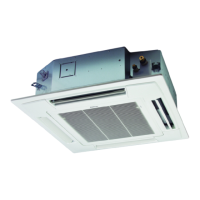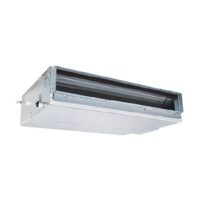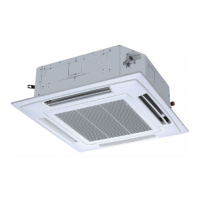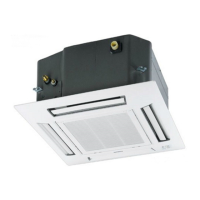200
WHEN CONNECTING THE DEMAND CONTROLLER INPUT
It is possible to choose various demand levels for the operating current. Refer to the table shown on the right.
Terminal no. for demand section Description
LV1 Approx. 70% of rated current
LV2 Approx. 40% of rated current
LV3 Stop
Connect the wiring (4-wire) to the Demand section (LV1, LV2, LV3, COM) on the terminal block.
Secure the wiring with the cord clamp located on the right side of the terminal block.
WHEN CONNECTING TO THE NEXT SYSTEM UNIT
• The Cooling / Heating Selector input and Forced Stop input can be transferred to the next system unit.
• Connecting cable to H05RN-F or H07RN-F which conforms to CENELEC (HAR) rating specifications, or use the
cables based on IEC standard. (245IEC57, 245IEC66) Diameter: 0.5 mm
2
.
• The maximum wire/cable length is 100 m.
• The demand control cannot be transferred to the next system unit.
• When transferring to the next system, the maximum number of connecting units is 30.
1. Connecting the wiring to the lower part of the terminal block.
When transferring to the next system unit with the Cooling / Heating Selector, connect the wiring (4-wire) to the
terminal points 1 through 4 on the lower part of the terminal block, and when transferring the Forced Stop input to
the next system, connect the wiring (2-wire) to the terminal points 5 and 6 on the lower part of the terminal block.
When transferring to the next system for either case, connect the wiring to the terminal points 1 through 6 on the
lower part of the terminal block.
Secure the wiring with the cord clamp located on the right side of the terminal block.
Be sure to connect the transfer line to the next system located on the lower part of the terminal block.
Connecting the transfer line to the upper terminal block can damage the device.
2. Connecting the wiring to the terminal block for the next system.
For the Cooling / Heating Selector, connect the wiring to the terminal points 1 through 4 on the upper part of the
the terminal block for the next system.
For the Forced Stop input, connect the wiring to the terminal points 5 and 6 on the upper part of the terminal
block for the next system.
When connecting to the next system for either case, connect the wiring to the terminal points 1 through 6 on the
upper part of the terminal block for the next system.
When connecting to the next outdoor system unit, be sure to connect to the appropriate terminal point due to the
polarity.

